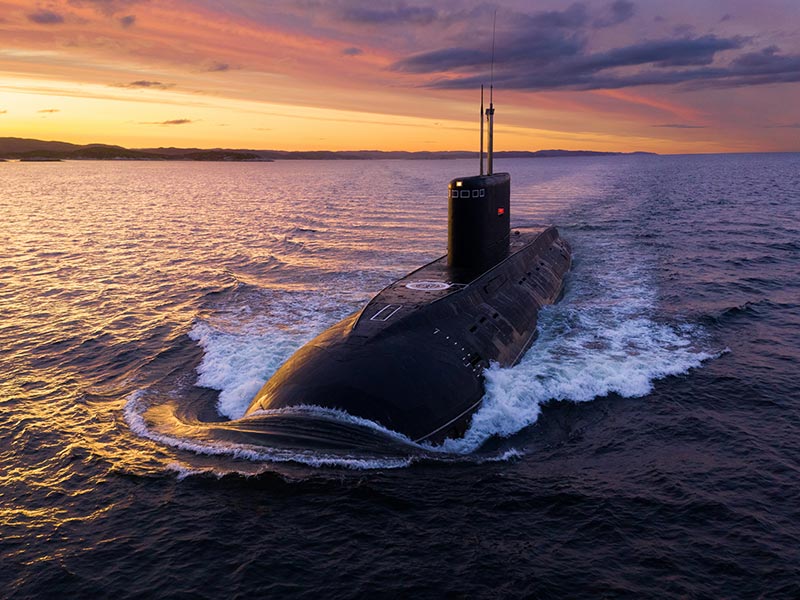Opinion: AUKUS is being examined by many brilliant minds, experts in history and the intricacies of the many dimensions of the geopolitical landscape. AUKUS is globally significant and sets Australia on a course for the rest of the century.
My examination of the AUKUS announcement is through a geo-tech and innovation lens.

Most of my career has been in the technology and digital spaces but this is not where I started. My undergraduate degree was Strategic Studies, receiving the vice-chancellors’ award for a research paper “Trade in Resources (Nuclear)”. Then as a civilian at the Air Power Studies Centre, I wrote the first edition of the RAAF’s Condensed Air Power Manual, and in the Department of Defence authored papers on force structure determinants.
The determinants of strategic strength and strategic weakness are in fact the same common patterns driving digital disruption. Strength becomes a weakness and vice versa. The rules change. The players change. The game changes. Often unexpectedly.
Innovation in strategy and policymaking are just as important as innovations in technology. In fact, technology innovations can often be in response to strategic innovations.
So, let’s look at AUKUS through a few different lenses.
On the surface, as espoused by our government, it’s a pivot to nuclear based on a changing geopolitical environment. Of course, it has the added benefit of removing tens of billions of dollars from the forward estimates at a time when COVID has decimated our economic outlook. And just in time for an upcoming federal election.
Running to the bosom of our Anglo-family also plays well when citizens feel afraid for their futures when they read of Chinese aggression amidst the heightened stress we have lived under for nearly two years with catastrophic fires and COVID.

Our sense of fair play has also been triggered. Preemptive media from our government talking luridly about broken promises and cost over-runs from the French side has laid the groundwork for a “good on us, lets walk away” attitude.
Perhaps well game played politically by our government, but what about our national defence?
The French submarine contract was based on extensive strategic studies and reviews over decades that identified a clear threat, with submarines as a key part of our response to that threat. Have the threats and sense of urgency evaporated? Far from it.
We have now entered what appears to be a lengthy study and consultation process that will result in us procuring US and UK nuclear submarine technology. But will it?
Absolutely integral to the AUKUS agreement is the inclusion of technologies such as cyber, quantum computing and artificial intelligence (AI).
And this is where innovation in strategy and policy comes into play.
In 2017, China announced its “Next Generation Artificial Intelligence Development Plan”, which laid out its ambition to become the world leader in artificial intelligence. The first step of that plan was to catch up with the US on AI technology and applications by 2020. The current phase, through to 2025, focuses on AI applied to health and medicine. By 2030, China’s ambition is to be the world leader in AI focussed on social governance and national defence.
Then in February 2019, the US responded with an Executive Order (13859) on “Maintaining American Leadership in Artificial Intelligence”. This Executive Order also prioritised an acceleration in the application of AI to defence and health.
The battlelines of the AI superpowers had been formally declared.
In the meantime, Australia has hollowed out its public sector capability; undervalued and underinvested in science, technology, engineering, and mathematics (STEM); defunded research; and has deep systemic deficits in cyber and digital.
Our geolocation, land mass and everything it represents, seen through one lens as a weakness, is being realigned as a strength from which we have negotiated. But the decades-long defunding of science and technology research and education has created a human capital strategic weakness. The question is, in this new deal, will our people be the mere recipients of technology transfer as espoused by the Prime Minister’s “adopter strategy”?
Will we always remain the technology takers, the technology adopters? In exchange for the treasures and convenience of our land mass?
Or will we use this realignment as a massive jolt to our science and technology human capital sovereign capability?
Any Australian voter disappointment (if any) at our walking away from the submarine manufacturing benefits and industry flow-on can be claimed to be offset by technology and other transfers from the broader agreement creating new industries and economic benefits.
But is this innovation or the artefacts of political gameplay? I think the Australian people can turn what was crafted through political gameplay into an innovation opportunity.
The Morrison Government AUKUS announcement has provided some distraction from their bungled vaccine rollout with the hope that the distraction will last for a few weeks until the states hit their vaccine targets and start to open their economies and borders.
They’ve also kicked the problems with the current submarine project down the road past this election and possibly the next.
But, by design or serendipity, we now have the flexibility to consider a range of strategic and tactical technology options, not just related to submarines.
All submarines have inherent problems that can be exploited by a knowledgeable antagonist. The broader scope of the AUKUS agreement enables us to develop technological supports that offset these problems whatever the option we choose. We can (in theory) receive a massive boost in technology transfer. We are all part of the Five Eye’s agreement, and so sharing secrets is much easier than under the just cancelled French contract.
Nuclear submarines require a supporting nuclear industry and highly trained and skilled nuclear engineers. I doubt we could even design one at this time let alone build, crew, and run one. Just look at our problems with performing these tasks on the conventional submarines.
But the innovation opportunity might look something like this.
The eighteen-month consultation period might yet reveal a strategic innovation option that could help close the massive and growing temporal gap between perceived threat and solution. This growing strategic threat-solution gap is something that cannot be allowed to fester.
One option could see Australia’s nuclear submarine capability redefined as delivery through a permanent hosting agreement or purchase/leasing of existing US/UK assets. That is, the US and possibly UK operate a fleet of nuclear submarines out of Australia. It makes geopolitical sense for the US and avoids the political instability and infrastructure problems inherent in some of their other regional options.
For the UK, Boris Johnson faces a dilemma if Scotland breaks from the UK under Nicola Sturgeon, and he must relocate their nuclear deterrent fleet out of Scotland. These won’t be moved to Australia; that makes no sense in terms of their deterrent effect in their own region, but it could be a massive face-saver for the British PM to extend the UK’s influence into the Pacific, especially as we are now a strong trading partner in the aftermath of Brexit.
AUKUS can be a game changer for Australian industry, even if we do decide to host a permanent US/UK submarine presence rather than build, buy or lease our own fleet.
Even this option would necessitate a massive infrastructure investment to house and operate any fleet. This is within our current capabilities and would still have many industry and economic spin-offs.
Through the strategic fleet hosting option, Australia could still play a role in operations, maintenance and logistics that would gradually expand our nuclear capabilities and provide us with more options when the next strategic replacement becomes due beyond mid-century.
Finally, AUKUS provides a badly needed capability and growth path in the asynchronous warfare being waged by terrorist groups around the globe. It is this predominantly digital domain that has far greater consequences and potential benefits for us than the “steel plate” focus of the submarines, no matter how sophisticated their combat systems.
Whatever the outcomes of the eighteen-month consultation period, mid-century is coming very fast. But what COVID has shown is that our education system, built for the 1950s, is fracturing right before our eyes; we can see that happening in our homes, and on the screens of our kids and grandkids doing “online learning”.
For the 2050s, the force structure determinants, whatever the options, will require a massive acceleration of human capital in science and technology education and research of nation building proportions. That pipeline starts now.
Marie Johnson was the Chief Technology Architect of the Health and Human Services Access Card program; formerly Microsoft World Wide Executive Director Public Services and eGovernment; and former Head of the NDIS Technology Authority. Marie is an inaugural member of the ANU Cyber Institute Advisory Board.
Do you know more? Contact James Riley via Email.


Marie Johnson’s AUKUS piece is an excellent analysis. Australia has been under investing in R&D and higher education research capacities in the last decade falling behind OECD countries. Where ever capacities existed ( solar technology for example) the capacity was taken over by Chinese. The country has recurrently destroyed its manufacturing capability (except in mining etc) – auto sector being a glaring example. Australia has no plans for nuclear industry and now embarking on Nuclear subs which entails building nuclear human resources. As Marie observes, ‘host a permanent US/UK submarine presence rather than build, buy or lease our own fleet’. With very knowledgeable think tanks and science policy experts, Australian government relies on private consultants in most matters of research, innovation and higher education. Australia is entering into ‘Black Box’ Nuclear Sub strategy which is unaware of the cost, technology transfer, manufacturing capabilities and extent of CSIRO or Universities involvement.
Venni Krishna, UNSW